Alaska Fish & Wildlife News
October 2020
Sea Lion Moms Foraging in Winter
New Tools Provide Greater Insights

Seven female Steller sea lions tagged in October 2019 have revealed insights into sea lion foraging in the Gulf of Alaska. The sea lions, all mothers with a pup and some also pregnant, were captured near Kodiak Island and equipped with remarkable devices that provide an unprecedented suite of information for sea lion researchers.
“It’s our first chance to look at females in the Gulf of Alaska using modern tools,” said Fish and Game wildlife biologist Mike Rehberg, a member of the department’s statewide Marine Mammal Program since 1999.
Rehberg said in the mid-1990’s researchers tracked female sea lions in the Gulf for a few weeks using older, less accurate satellite tracking technology, and found they mostly stayed near the coast. But based on reports from fishery observers, research vessels and other ships, biologists knew sea lions were foraging as far as 100 miles south of Kodiak Island at the edge of the continental shelf.
Steller sea lions began disappearing in the late 1980s and 1990s, leaving Alaska haulouts and beaches once teeming with the animals empty or nearly vacant. They were listed as threatened under the Endangered Species Act in 1990, and sea lions west of Cape Suckling (near Kayak Island) were upgraded to endangered in 1997, which affected commercial fisheries. The decline in numbers was far greater in some areas than others, and some rookeries (where sea lions gather to breed) saw increases in numbers. Biologists needed to learn more about sea lions’ movements, foraging behavior and diet, reproduction, and stocks – distinct population groups. They needed to develop tools and skills to capture animals, mark them, and track them.
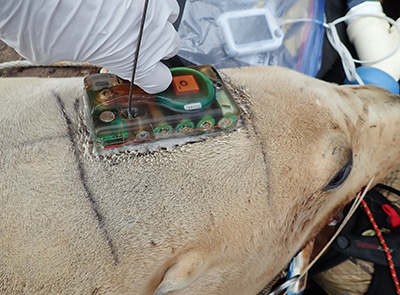
The recently tagged animals revealed that some females are making up to 200-mile round-trip foraging excursions in just a few days, leaving their pup to wait at a haulout on shore, and diving from as deep as 430 meters to feed. Others focused on shallower waters closer to shore.
Tags Tell the Tales
A small satellite tracking device, collecting GPS locations, epoxied to the fur on a sea lion’s head provided the data. Rehberg said earlier GPS devices didn’t work for diving animals like sea lions.
“When they surfaced there wasn’t enough time to connect with the satellites and get a hit. These tags collect GPS information differently, so the moment the animal’s head breaks the surface of the water it gathers the data it needs.”
The head tag provides the animals’ location, how deep they are diving, how long they spend underwater, whether they are hauled out on land or swimming in water, and the temperature of the ocean where they’re diving. “All the information is stored in the memory of the tag,” Rehberg said. “It’s collecting continuously, then when it gets a chance it sends the data to us.”

The head tags fall off when the animals molt, an annual late-summer occurrence, but the batteries don’t last that long. All the tags transmitted successfully between October 2019 and March 2020, when they began going “off the air.” Two continued transmitting into June 2020 and finally quit in mid-summer. There’s backup, however. The sea lions are also equipped with flipper-mounted tracking tags, something previously used only on harbor seals and ice seals.
“We wanted to know if we could use flipper tags for long periods of time,” Rehberg said. “The flipper tag can’t transmit the radio signal underwater, so they only give us locations when sea lions are hauled out on land. But the flipper tags don’t fall off and they are quite small and very lightweight, less than 30 grams. When the sea lions are hauled out they tell the satellites where they are. They provide data on seasonal movements and selection of haulout places.”
Rehberg noted that his colleague Justin Jenniges recently informed him that six of the seven tags are still online and the females have returned to the same haulouts where they were captured last October.
“They are back where they started,” he said. “It’s exciting to see them show up again in the same spot. Females tend to stick around in the same spot winter to winter, they are creatures of habit and use the same rookeries and same haulouts year to year.”
Predation and Breeding Strategies
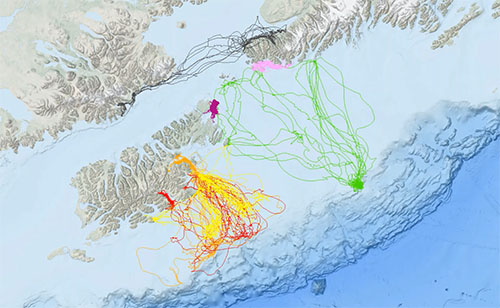
Sea lions are generalist predators, as opposed to specialists that focus on certain prey. As generalists, individuals develop foraging preferences and styles that suit the prey, region and opportunities at hand. That’s particularly true of females, who often have a pup to consider.
“Each female has her own thing, some tend to be shallower divers, some deeper divers,” Rehberg said. “Most of their foraging seems to be close to the sea floor - some diving is in the water column for pelagic fish - but most seems close to the seafloor no matter how deep it might be, and we think they are targeting demersal (bottom-dwelling) fish.”
Rehberg compared the Kodiak sea lions to four females that researchers tracked in Prince William Sound in 2018. He said while they had the same energy needs, and also had pups to support, they employed a different strategy, staying right in the sound where all their needs were met.
“They spent time foraging close to shore, always in a fjord, near an island, off a reef, pretty close to land,” he said. “They swam much shorter distances but made much deeper dives. The trade-offs are different. They are aiming for black cod and squid, and they’re making over 400-meter dives.”
“Our deepest diver was in Prince William Sound, and her deepest dive was 600 meters (over one-third of a mile) and lasted 10 minutes.”
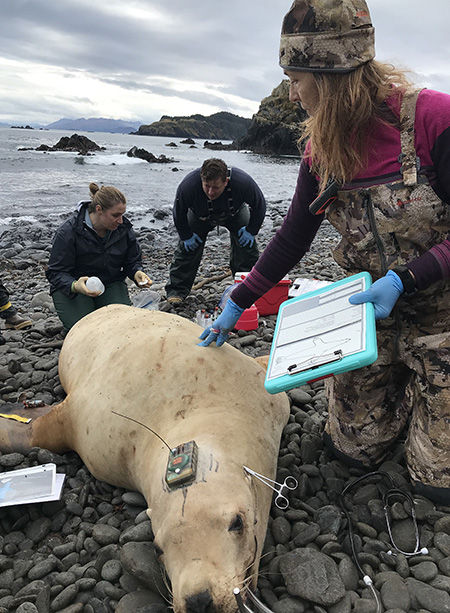
He added that the deepest dives made by a sea lion are not their longest duration dives. Because sea lions are busy pursuing prey and have limited energy and time to do this, they tend to optimize their time underwater to keep themselves in the thick of a prey patch as long as possible per dive. And so, a relatively shallow 60-meter dive off Kodiak lasted more than 12 minutes, and a Prince William Sound dive of only 100 meters lasted 10 minutes.
Kodiak sea lions kept their foraging over the continental shelf, he said, avoiding deeper water offshore, while Prince William Sound females had access to very deep water close to shore. “Likewise, we see a Kodiak female making long, multi-day trips out to the continental shelf of 100 miles each way. She is optimizing her time out at a presumably thick patch of prey.”
Parental responsibilities are a factor. “We think a female Steller sea lion is pregnant or lactating for most of her adult life,” he said. “And lactation is the most expensive thing energy wise.”
The pup stays with mom for a year, and she may also be pregnant and due to give birth the following June. She needs to feed. Other animals take a different approach, drawing on stored reserves.
Rehberg said elephant seals and harbor seals employ what’s known as a capital breeding strategy. They fatten up before breeding season, have their pup, and fast while they stay with it for several weeks. They basically tank up the pup with as much energy as possible, he said, then the pup weans fairly quickly. A sea lion is more like humans or fur seals, known as income breeders. A female sea lion must keep foraging to keep suckling its pup for close to a year or longer as opposed to a few weeks. For that time, she must juggle foraging for herself (and via lactation, her pup as well) with visits to the haulout to feed her pup.
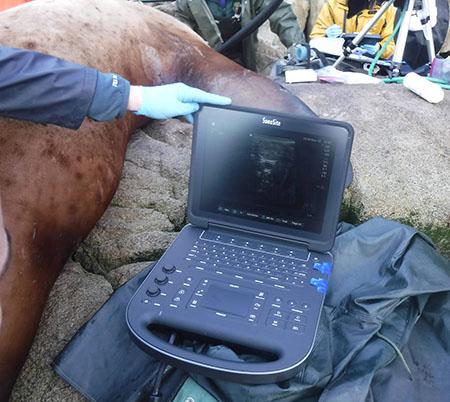
“We see a common pattern, they go out to sea and spend two days or so, then come back and stay with their pup a couple of days.” Rehberg said. “Two and a half days is about the limit the pup can fast without burning into its energy stores, that’s the constraint on the female sea lion. They are working around this.”
Last October, the capture team was joined by Dr. Michelle Shero from Woods Hole Oceanographic Institute in Cape Cod, Mass. An expert in pregnancy in marine mammals, she performed ultrasound exams on the females during the capture processing to determine if they were pregnant. Typically, Steller sea lion females would be pregnant in October, after breeding in June. June is also when they typically give birth. But there’s an added twist.
“Some will not have a new pup in June and will keep last year’s pup for another year,” Rehberg said. “They breed in June, but the embryo doesn’t implant until September or October, so then they can become pregnant. Sometimes implantation does not happen. So with the ultrasound we could see if an embryo was developing.”
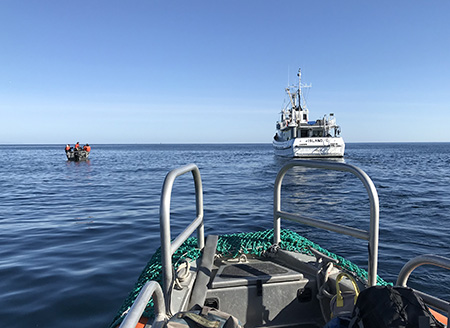
Researchers want to understand when and why a female sea lion implants or does not implant the embryo, why she chooses to retain her pup or not, and what influences those choices.
Sea Lion Captures
In October 2019, researchers set sail from Homer aboard the R/V Island C, bound for Kodiak. The team included ADF&G’s wildlife veterinarian, Dr. Kimberlee Beckmen, and Dr. Michelle Oakley, a volunteer veterinarian from Haines Junction in the Yukon Territory. In addition to Michael Rehberg, ADF&G Marine Mammal Program researchers Mandy Keogh, Sue Goodglick, Tom Gage, Justin Jenniges and Greg Snedgen were aboard, joined by Michelle Shero from Woods Hole Oceanographic Institute.
“We worked out of the larger charter boat, where we live and eat and travel,” Rehberg said. “It takes us from haulout to haulout. We anchor up and work from there for a couple days or a week.”
Wildlife biologists capture and process animals like bear, moose, and caribou using immobilizing drugs delivered by a dart.
But drugging a marine mammal poses a problem. Darted at a haulout, a drugged sea lion could jump in the water and drown.

In the past, sea lion researchers focused on the smaller and much more manageable juveniles. Curious and less wary, they were receptive to techniques that enable a couple of divers in the water near a haulout to lure them in close and essentially lasso them underwater with a special noose. A crew in a nearby skiff quickly restrained the young sea lion, brought it aboard and carried it back to the research vessel for processing.
However, adults were much too big to capture and haul onboard a skiff like this - the females tagged in 2019 weighed 270 – 340 kg (about 600 to 750 pounds). The key to their capture was new drugs, developed and tested in 2010, which have made it possible to safely capture adult sea lions by darting them on their haulouts. If a darted sea lion does escape to the water, the drugged animal floats and slowly swims at the surface as it recovers. Rehberg described this as safe and forgiving, and a dart with a second drug can reverse or counteract the effects, reviving the animal more quickly.
“It puts them to sleep like we want, but we know that even if she gets away from us she’ll basically sleep it off while she’s swimming,” Rehberg said. “We’ve monitored them floating near the surface, blowing bubbles, without drowning or difficulty.”
A sea lion successfully darted on the beach is quickly attended to by the capture team, including the veterinarians.
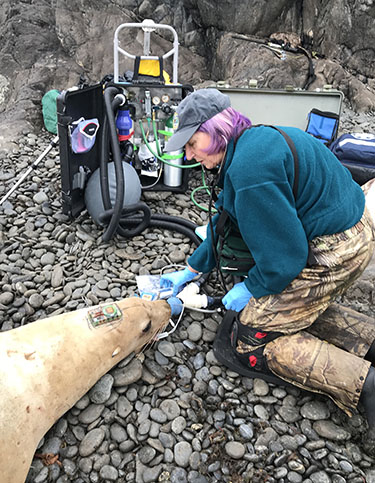
“They are responsible for the safety of animal, the anesthesia, and reversing,” Rehberg said. “We get started with the capture drug, then a tube is used to hold the sea lions under gas anesthesia. That’s preferred, it provides better control because the vets can keep them right on the plane of anesthesia we need. But sometimes we don’t have enough time, and so we do what we can under the capture drug and then reverse it.”
The animals are equipped with the tags, samples and measurements are taken, and they are marked with a unique number code.
“Catching adults is hard, you get one shot,” Rehberg said. “We disrupt the entire haulout when we do a capture. My colleagues have gotten really good at being quick. On the scene we judge the situation, go down the list and depending on how much time we think we’ve got we get as much data as possible. Sometimes we are working near the surf and need to work fast.”
Marking or branding the animal is particularly important. Thousands of sea lions from Oregon to the Russian Far East have been branded since the 1990s, usually as pups at their natal rookeries. Re-sighting animals over the years provides a wealth of information regarding their movements, preferences for specific rookeries and haulouts, and reproductive history.
“We’ve gotten good at branding very quickly,” Rehberg said. “The branding and re-sight program is our longest investment in sea lion ecology. It’s been a coordinated effort for more than 20 years now involving the Alaska Department of Fish and Game, NOAA Marine Mammal Lab, the Alaska Sea Life Center, the Oregon and Washington Departments of Fish and Wildlife, and also the Kamchatka Branch of the Russia’s Pacific Geographical Institute.”
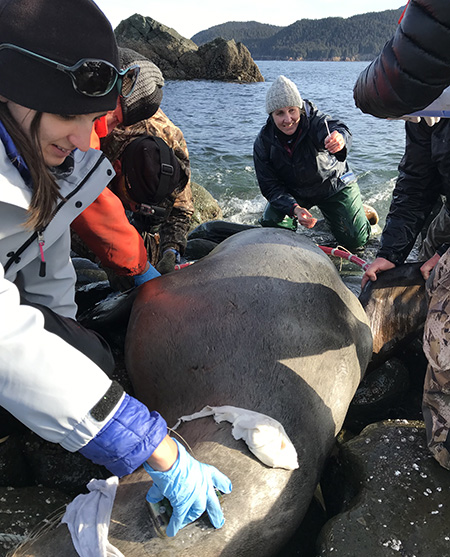
Re-sighting branded animals has provided insight into the females’ preference for certain rookeries for birthing their pups. Rehberg pointed to a study Fish and Game biologist Kelly Hastings published and offered highlights: Females have moderately high “natal philopatry,” that is, young females tend to choose their own rookery of birth as the place to begin breeding themselves. Once females begin to breed, they have very high fidelity to these pupping sites year after year.
A lot has happened in sea lion research in the past 20 years, building on early work like branding. Techniques developed two decades ago still provide benefits.
“If we need to catch juveniles, we can get six in a couple dives in a morning with the underwater restraint method,” Rehberg said.
But the new drug, developed by a group of veterinarians led by Dr Marty Haulena of Vancouver Aquarium, is a breakthrough. “It used to take 13 people to do dive captures, now we can do it with four or five if we have to. This new tool needs fewer people, less gear, less training, it’s so much easier.”
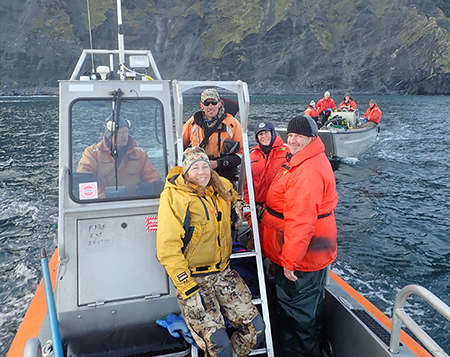
This two-minute animation shows the movements of seven GPS-tagged female Steller sea lions in the Gulf of Alaska
This work is funded by a NOAA Species Recovery Grant to the Alaska Department of Fish and Game (Award NA18NMF4720088). The statements, findings, conclusions, and recommendations are those of the author(s) and do not necessarily reflect the views of NOAA Fisheries or the U.S. Department of Commerce.
These federal dollars require matching funds. Our program’s continued research depends on contributions of non-federal matching dollars as both cash and in-kind services.
For more information, please contact dfg.dwc.sealions@alaska.gov
Riley Woodford is the editor of Alaska Fish and Wildlife News and produces the Sounds Wild! radio program.
Subscribe to be notified about new issues
Receive a monthly notice about new issues and articles.
